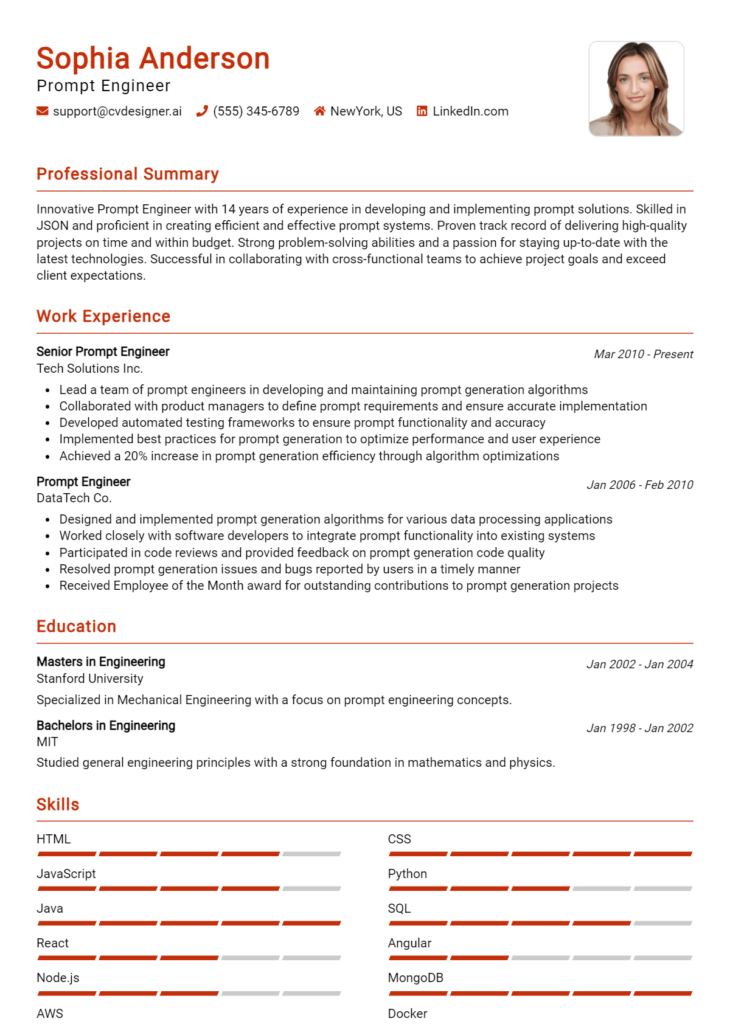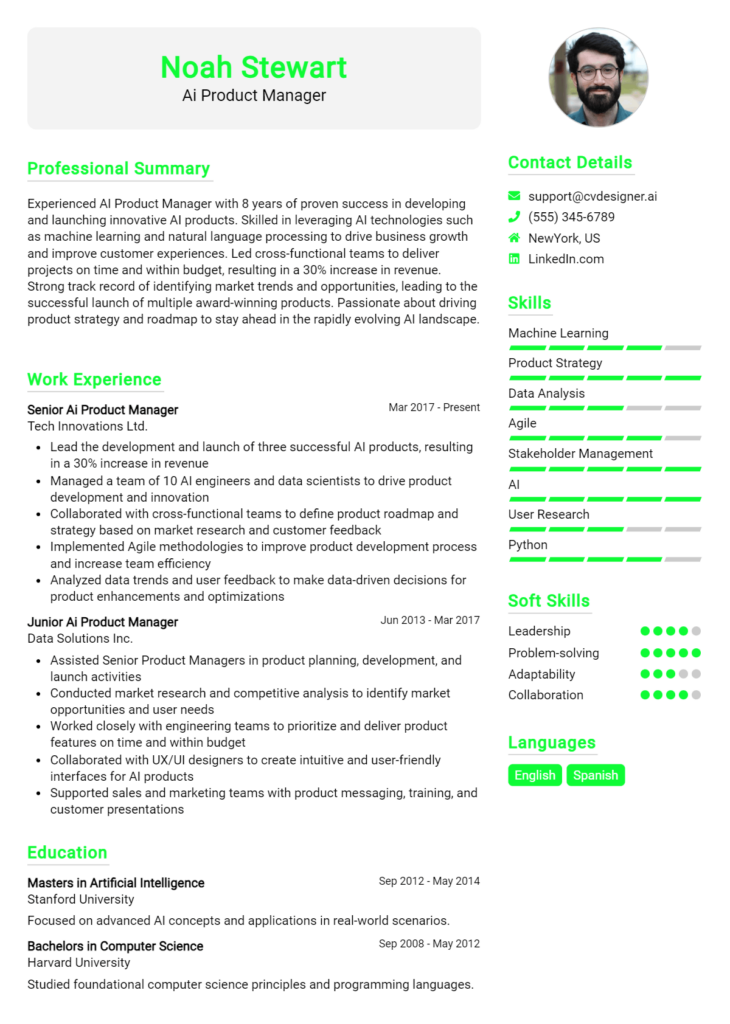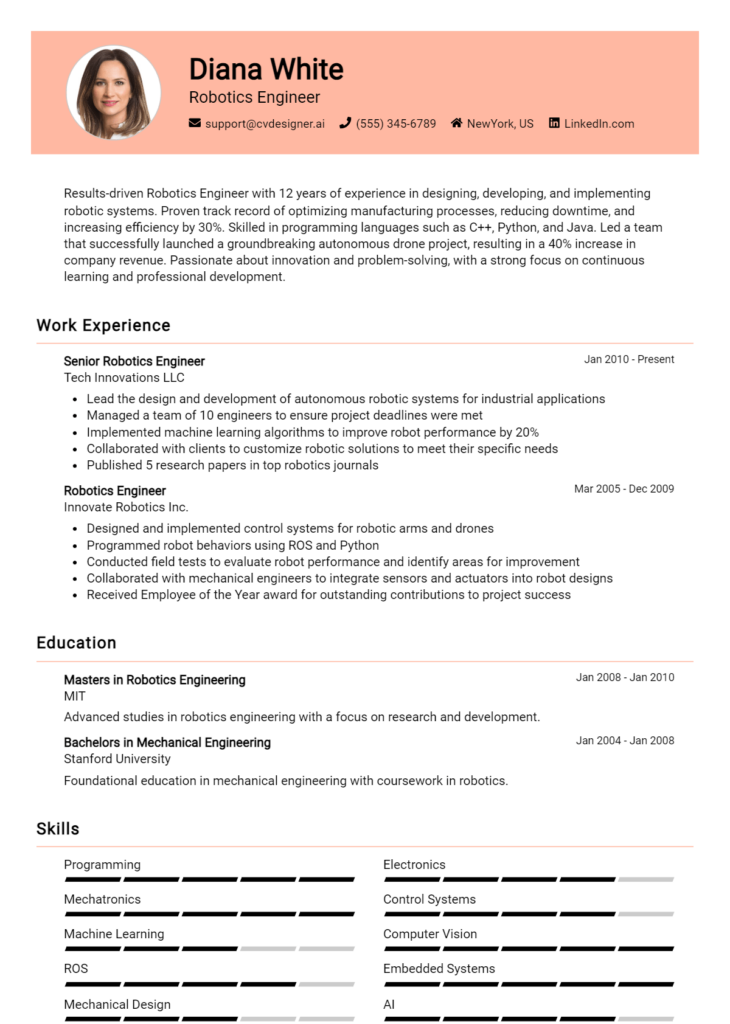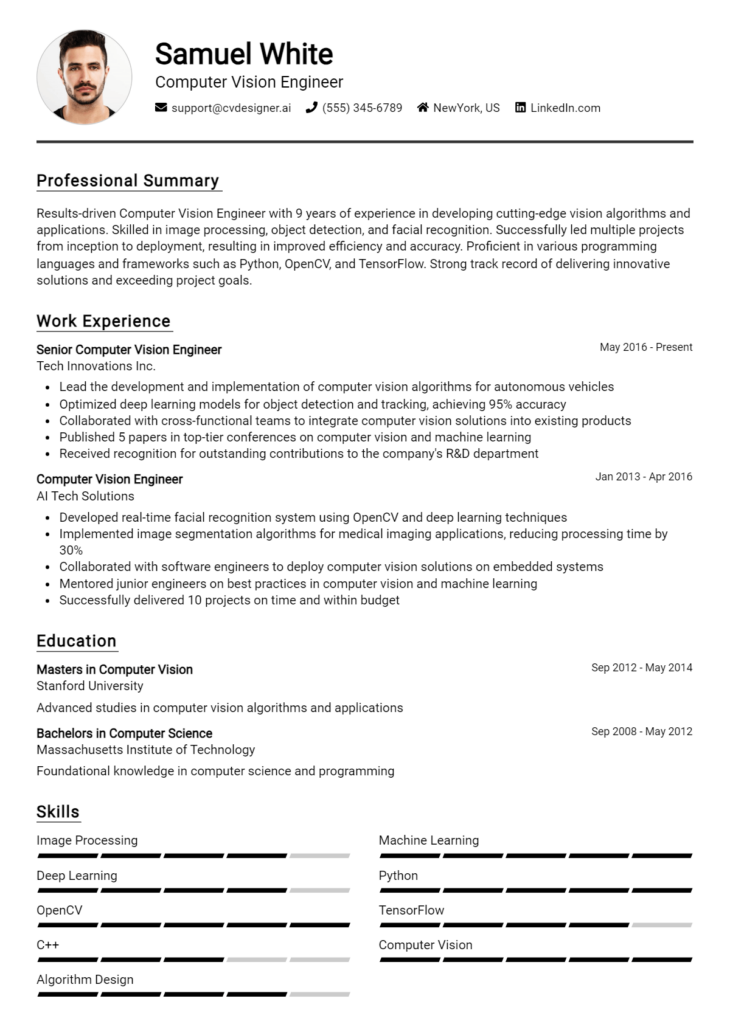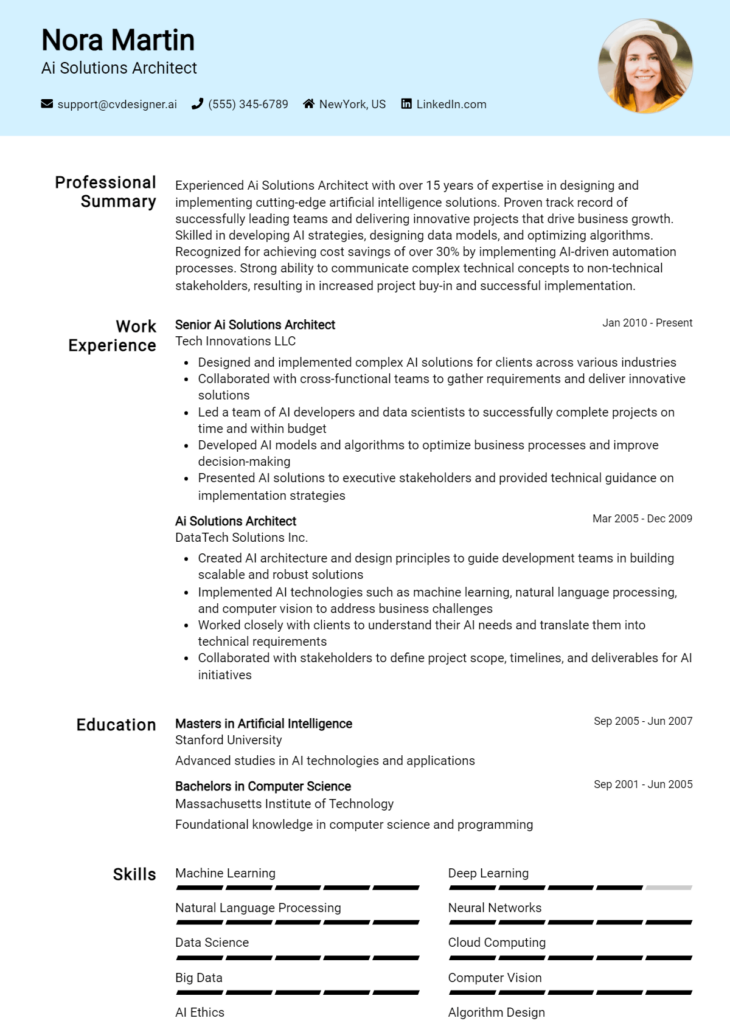Most Popular Machine Learning Engineer Resume Examples
Explore additional Machine Learning Engineer resume samples and guides and see what works for your level of experience or role.
As a Machine Learning Engineer, you stand at the forefront of technological innovation, harnessing the power of data to create intelligent solutions that drive progress across various industries. The significance of your role cannot be overstated; it combines advanced programming skills with a deep understanding of algorithms and statistical analysis to build models that learn and adapt. However, even the most skilled professionals can be overlooked without a well-crafted resume that showcases their unique talents and experiences. An impactful resume is your ticket to standing out in a competitive job market, and this guide is designed to help you create one that effectively highlights your qualifications.
In this comprehensive resume writing guide, we will delve into the key responsibilities and skills that define a successful Machine Learning Engineer, ensuring you know what to emphasize. We’ll discuss the best formats to present your resume, helping you choose the layout that will catch the eye of recruiters. Additionally, we’ll cover common mistakes to avoid, so you can steer clear of pitfalls that might undermine your chances of landing an interview. You’ll find resume examples tailored for all experience levels, from entry-level positions to seasoned professionals. Plus, we’ll provide invaluable tips on crafting your resume and selecting the right resume templates to enhance your presentation. Whether you're just starting out or looking to advance your career, this guide will equip you with the knowledge to create a standout resume that opens doors to new opportunities.
Key Responsibilities and Skills for a Machine Learning Engineer
A Machine Learning Engineer plays a pivotal role in developing algorithms and models that enable machines to learn from data. This position involves a combination of programming, data analysis, and machine learning techniques to create systems that can improve performance over time without being explicitly programmed.
Key Responsibilities:
- Design and develop machine learning models and algorithms tailored to specific business needs.
- Conduct experiments to optimize and validate models, ensuring accuracy and efficiency.
- Collaborate with data scientists and software engineers to integrate models into production systems.
- Analyze large datasets to identify trends, patterns, and insights that can inform model development.
- Monitor and maintain machine learning models post-deployment to ensure continued performance.
- Document processes and present findings to stakeholders in a clear and comprehensible manner.
Essential Skills:
- Proficiency in programming languages such as Python, R, or Java.
- Strong understanding of machine learning frameworks and libraries (e.g., TensorFlow, PyTorch, Scikit-learn).
- Experience with data manipulation and analysis tools (e.g., Pandas, NumPy).
- Knowledge of statistical analysis and data mining techniques.
- Familiarity with cloud platforms (e.g., AWS, GCP, Azure) for deploying machine learning models.
- Problem-solving skills and the ability to work with complex datasets.
- Effective communication skills to convey technical concepts to non-technical stakeholders.
Highlighting these skills effectively in the resume skills section is crucial, as it showcases your qualifications and aligns your expertise with the job requirements. Tailoring your responsibilities and skills to match the specific job description can significantly increase your chances of getting noticed by hiring managers. Additionally, consider how these skills can be relevant in crafting a strong CV, demonstrating your capabilities and readiness for the challenges of a Machine Learning Engineer role.
Best Resume Format and Structure for a Machine Learning Engineer
When crafting a resume for a Machine Learning Engineer position, it's essential to choose a format that highlights your technical skills, relevant experience, and educational background. Below is a detailed guide on the best resume format and structure for this role.
Contact Information
This section should be placed at the top of your resume. Include the following details:
- Full name
- Phone number
- Professional email address
- LinkedIn profile link
- GitHub or personal website showcasing your projects (if applicable)
Professional Summary
Write a concise summary (2-3 sentences) that outlines your experience, key skills, and what you aim to achieve in your next role. Tailor this section to reflect your expertise in machine learning, your familiarity with specific tools, and your passion for the field. For example:
"Results-driven Machine Learning Engineer with over 5 years of experience in developing predictive models and deploying machine learning algorithms. Proficient in Python, TensorFlow, and data visualization, with a proven track record of improving operational efficiency through data-driven decision-making."
Work Experience
This section should be formatted in reverse chronological order, listing your most recent job first. For each position, include:
- Job Title
- Company Name
- Location (City, State)
- Dates of Employment (Month/Year - Month/Year)
- Bullet points detailing your responsibilities and achievements. Use action verbs and quantify your results where possible. For example:
- Developed and implemented machine learning models to enhance product recommendations, leading to a 20% increase in user engagement.
- Collaborated with cross-functional teams to integrate AI solutions into existing systems, resulting in a 30% reduction in processing time.
Education
List your educational qualifications in reverse chronological order, including:
- Degree (e.g., Bachelor of Science in Computer Science)
- Institution Name
- Location (City, State)
- Graduation Date (Month/Year)
- Relevant coursework or projects can be included if applicable.
Skills
Include a section dedicated to your technical skills. Focus on a mix of hard and soft skills relevant to machine learning, such as:
- Programming Languages: Python, R, Java
- Frameworks and Tools: TensorFlow, Keras, Scikit-learn, PyTorch
- Data Handling: SQL, Pandas, NumPy
- Other Skills: Data visualization tools (Tableau, Matplotlib), cloud platforms (AWS, Azure), and understanding of algorithms and data structures.
Certifications
List any relevant certifications that enhance your qualifications as a Machine Learning Engineer. Include:
- Certification Name (e.g., Google Cloud Professional Machine Learning Engineer)
- Issuing Organization
- Date Obtained
Additional Sections
Depending on your experience and relevance, consider adding sections such as:
- Projects: Briefly describe personal or open-source projects related to machine learning.
- Publications: If applicable, include any research papers or articles you’ve published.
- Professional Affiliations: Membership in organizations like IEEE or ACM can also be included.
Cover Letter Format Complement
A well-structured resume should complement your cover letter. While the cover letter allows for a more personalized narrative of your experiences and motivation, your resume provides the factual basis. Ensure that both documents reflect a cohesive story about your professional journey in machine learning. Use similar language and themes to create a unified presentation of your candidacy.
By following this structured approach and using a clean, professional format (such as chronological or combination), you can effectively present your qualifications as a Machine Learning Engineer while making a strong impression on potential employers.
Writing Tips and Best Practices for a Machine Learning Engineer Resume
Crafting a compelling resume as a Machine Learning Engineer requires a strategic approach that highlights your technical skills, relevant experience, and contributions to past projects. Start by showcasing your proficiency in machine learning frameworks, programming languages, and data analysis tools. Use clear, concise language to describe your accomplishments, ensuring that you quantify achievements where possible. This will not only demonstrate your capabilities but also provide tangible evidence of your impact in previous roles. For a polished and professional look, consider utilizing resume writing tips that can enhance the overall presentation of your resume. Remember, these best practices are also beneficial when drafting a cover letter, where you can further elaborate on your experiences and fit for the role.
- Use action verbs such as "developed," "implemented," "optimized," and "analyzed" to convey your contributions effectively.
- Quantify your achievements by including metrics, such as "increased model accuracy by 15%" or "reduced processing time by 30%."
- Incorporate industry-specific keywords relevant to machine learning, such as "deep learning," "natural language processing," and "neural networks" to pass through applicant tracking systems.
- Tailor your resume for each job application by aligning your skills and experiences with the job description.
- Highlight collaborative projects, emphasizing your ability to work within a team and communicate complex concepts to non-technical stakeholders.
- Include a dedicated section for relevant certifications, courses, and workshops to showcase your commitment to continuous learning in the rapidly evolving field of machine learning.
- Keep your resume layout clean, using bullet points for easy readability, and ensure consistent formatting throughout.
- Proofread your resume multiple times to eliminate any grammatical errors or inconsistencies that could undermine your professionalism.
Common Mistakes to Avoid in a Machine Learning Engineer Resume
Crafting an effective resume as a Machine Learning Engineer is crucial in making a strong impression on potential employers. However, many candidates fall into common pitfalls that can detract from their qualifications and experiences. By being aware of these mistakes and addressing them, you can enhance your resume and increase your chances of landing an interview. Here are some common mistakes to avoid:
- Overloading with Information: Including too much technical jargon or excessive details can overwhelm the reader.
- Using Generic Descriptions: Failing to tailor your experience to the specific job description can make your resume blend in with others.
- Neglecting Soft Skills: Focusing solely on technical skills while ignoring teamwork, communication, and problem-solving abilities can present an incomplete picture.
- Ignoring Formatting: A cluttered or inconsistent layout can distract from the content and make it difficult to read.
- Lack of Quantifiable Achievements: Not providing metrics or specific examples of your impact in previous roles can weaken your claims.
- Inconsistent Terminology: Using different terms for the same skills or technologies can confuse hiring managers.
- Failing to Update: Not keeping your resume current with your latest projects or skills can make you seem out of touch.
- Not Highlighting Relevant Projects: Omitting significant projects that showcase your machine learning capabilities can lead to missed opportunities.
- Using Passive Language: Employing passive voice instead of active voice can reduce the impact of your achievements.
- Ignoring the Cover Letter: Overlooking the importance of a well-crafted cover letter can diminish the overall strength of your application.
To ensure your resume stands out and effectively communicates your qualifications, consider reviewing these common mistakes to avoid in a resume and complementing it with a thoughtful cover letter by avoiding common cover letter mistakes.
Sample Machine Learning Engineer Resumes
As the demand for machine learning expertise continues to rise, creating a standout resume is essential for aspiring and experienced Machine Learning Engineers alike. Below are three sample resumes tailored to different experience levels: one for an experienced professional, one for an entry-level candidate, and one for a career changer. These examples will help you craft a compelling resume that highlights your skills, experiences, and accomplishments in the field of machine learning. For additional inspiration, explore more resume examples and don't forget that effective cover letter examples can help complete your job application package.
Experienced Machine Learning Engineer Resume
John Doe
123 Data St., Tech City, CA 90210
(555) 123-4567
johndoe@email.com
Professional Summary
Results-driven Machine Learning Engineer with over 7 years of experience in designing and implementing predictive models and algorithms. Proficient in Python, R, and TensorFlow, with a proven track record of enhancing product functionality and improving decision-making processes through data-driven insights.
Technical Skills
- Programming Languages: Python, R, Java, SQL
- Machine Learning Frameworks: TensorFlow, Keras, scikit-learn
- Tools: Jupyter, Git, Docker, AWS
- Databases: MySQL, MongoDB
- Other: Data Visualization, Statistical Analysis, Natural Language Processing
Professional Experience
Senior Machine Learning Engineer
ABC Tech Solutions, San Francisco, CA
January 2020 - Present
- Developed machine learning models that improved customer retention rates by 30% through predictive analytics.
- Collaborated with cross-functional teams to integrate machine learning algorithms into existing systems.
- Conducted A/B testing and data analysis to optimize marketing strategies, resulting in a 25% increase in ROI.
Machine Learning Engineer
XYZ Innovations, Los Angeles, CA
June 2016 - December 2019
- Designed and implemented machine learning algorithms for image recognition, achieving 95% accuracy in classification tasks.
- Worked with data scientists to preprocess and analyze large datasets, improving model training time by 40%.
- Presented findings and model results to stakeholders, facilitating data-driven decision-making.
Education
Master of Science in Computer Science
University of California, Berkeley
Graduated: May 2016
Certifications
- Certified TensorFlow Developer
- AWS Certified Machine Learning - Specialty
Entry-Level Machine Learning Engineer Resume
Jane Smith
456 Tech Ave., Innovation City, CA 90211
(555) 987-6543
janesmith@email.com
Professional Summary
Enthusiastic and detail-oriented recent graduate with a Master's degree in Data Science and hands-on experience in machine learning projects. Familiar with Python, machine learning libraries, and data visualization techniques, eager to contribute to innovative projects in a dynamic team environment.
Technical Skills
- Programming Languages: Python, R
- Machine Learning Libraries: scikit-learn, Keras
- Tools: Jupyter, Git
- Databases: SQLite
- Other: Data Analysis, Data Visualization
Education
Master of Science in Data Science
University of California, San Diego
Graduated: May 2023
Relevant Projects
- Predictive Analytics for Sales Forecasting: Developed a predictive model using Python and scikit-learn to analyze sales data, resulting in improved forecasting accuracy by 20%.
- Image Classification System: Created a convolutional neural network (CNN) using Keras to classify images from a public dataset, achieving 90% validation accuracy.
Internship Experience
Data Science Intern
Tech Solutions Co., San Diego, CA
June 2022 - August 2022
- Assisted in the development of machine learning models for customer segmentation and behavior analysis.
- Conducted exploratory data analysis and visualized data trends using Python libraries such as Matplotlib and Seaborn.
Career Changer Machine Learning Engineer Resume
Michael Lee
789 Innovation Blvd., Future City, CA 90212
(555) 321-0987
michaellee@email.com
Professional Summary
Dedicated professional transitioning from a career in software development to machine learning engineering. Over 5 years of experience in software development and a strong foundation in algorithms and data structures. Currently pursuing hands-on experience in machine learning techniques and applications.
Technical Skills
- Programming Languages: Python, Java, C++
- Machine Learning Libraries: TensorFlow, scikit-learn
- Tools: Jupyter, Git, Docker
- Databases: PostgreSQL
- Other: Software Development, Algorithm Design, Data Structures
Professional Experience
Software Developer
Tech Innovators, San Francisco, CA
January 2018 - Present
- Developed and maintained scalable software applications, contributing to a 15% reduction in system downtime.
- Collaborated with teams to design and implement new features based on user feedback and performance metrics.
Education
Bachelor of Science in Computer Science
Stanford University, Stanford, CA
Graduated: June 2017
Machine Learning Projects
- Sentiment Analysis Tool: Created a sentiment analysis tool using Python and natural language processing (NLP) techniques to analyze customer reviews, achieving an accuracy rate of 85%.
- Recommendation System: Developed a collaborative filtering recommendation system for an e-commerce platform, improving user engagement by 30%.
Certifications
- Machine Learning Specialization (Coursera)
- Python for Data Science and AI (IBM)
Checklist for a Machine Learning Engineer Resume
- Proofread for Spelling and Grammar: Carefully review your resume for any spelling or grammatical errors. Utilize tools like Grammarly or have a friend review it to catch mistakes you might have missed.
- Consistency in Formatting: Ensure that fonts, bullet points, and spacing are consistent throughout your resume. This includes headings, subheadings, and text alignment.
- Tailor Your Resume: Customize your resume for each job application by incorporating relevant keywords and phrases from the job description. This helps to demonstrate your fit for the role.
- Highlight Relevant Skills: Clearly list your technical skills, such as programming languages (Python, R), machine learning frameworks (TensorFlow, PyTorch), and tools (scikit-learn, Keras) that are pertinent to the job.
- Quantify Achievements: Whenever possible, quantify your accomplishments (e.g., "Improved model accuracy by 20%") to provide concrete evidence of your contributions and impact.
- Keep It Concise: Aim for a one-page resume or a maximum of two pages. Focus on the most relevant experiences and skills that align with the job you are applying for.
- Include a Projects Section: Showcase significant machine learning projects, including your role, the technologies used, and the outcomes. This demonstrates practical application of your skills.
- Use a Professional Email Address: Ensure your contact information includes a professional email address that reflects your name, avoiding any unprofessional or informal addresses.
- Utilize an AI Resume Builder: Consider using an AI resume builder to help organize your resume effectively, ensuring all elements are well-structured and visually appealing.
- Follow a Similar Checklist for CVs: If you are also creating a CV, a similar checklist can be followed to maintain quality and consistency in your academic and professional documentation. Check out available templates at CV Designer.
Key Takeaways for a Machine Learning Engineer Resume Guide
Crafting a compelling resume as a Machine Learning Engineer is crucial for standing out in a competitive job market. By leveraging the examples and tips provided, you can effectively showcase your technical skills, project experience, and problem-solving abilities. Remember to tailor your resume to highlight the most relevant aspects of your background that align with the job description. As a next step, consider downloading a professionally designed template from resume templates or a tailored cover letter template from cover letter templates. Additionally, you might find our best resume maker helpful in putting together a polished application that reflects your unique qualifications. Take these steps to enhance your job search and increase your chances of landing that coveted Machine Learning Engineer position!
